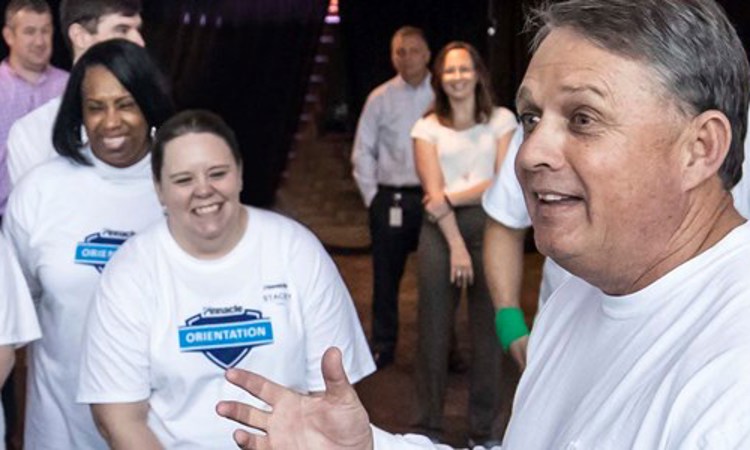Rewriting the Narrative: How Access, Equity, and Advice Can Change Everything for Homeowners in Marginalized Communities
By Kandace Harris, client service advisor at Pinnacle Financial Partners
For decades, many minority homeowners have lived with a lingering fear and stigma around borrowing against their homes. The phrase “second mortgage” still carries heavy emotional weight in many minority communities, and for good reason.
But what if the problem wasn’t the product but the troubled history, misinformation and lack of guidance that surrounded it?
Pinnacle Financial Partners is helping homeowners in majority-minority communities reclaim their equity—safely, strategically and with trusted support.
Banking is a business of improvement. We work to help improve people’s finances, businesses and homes. We seek to help improve their standing in the world and the legacies they leave to their families. That daily work has a cumulative effect that reaches outside of the direct service we give to clients. It should help improve quality of life for an entire community and as many communities and people as we can.
Redlining: A Legacy That Still Echoes
To understand the skepticism around products like second mortgages or home equity lines of credit (HELOCs), you must look at the history of redlining.
In the 1930s, the federal government and banking institutions literally drew red lines around Black, immigrant and other non-white neighborhoods on housing maps. These areas were deemed “high risk” for lending—not because of data, but because of race. As a result:
- Black and brown families were denied fair mortgages, even with good credit.
- White families in “green-lined” areas accessed low-cost loans and built wealth.
- Homes in redlined neighborhoods lost value, while white neighborhoods appreciated.
This led to a massive racial wealth gap that persists today. By 2020, the average Black family held one-tenth the wealth of the average white family, largely due to homeownership disparities.
And when financial institutions did finally return to redlined areas, it was often through predatory subprime loans and high-interest second mortgages that set families up to fail.
The result? A deep mistrust of lending, especially when it comes to tapping home equity.
How HELOCs Can Work Differently
At Pinnacle Financial Partners, we believe access to equity should not depend on zip code, credit score or outdated perceptions of risk.
Pinnacle has intentionally designed how it meets the needs of every community, empowering local leaders to set goals and guide associates dedicated to offering these specialized products.* With the right people, right products and an approach that fits Pinnacle’s model, we’re able to serve more majority-minority communities and low- to moderate-income people.
Here’s what makes this product different:
- More flexible credit score requirements
- Higher allowable debt-to-income ratios
- No closing costs
- Fair, transparent interest rates
- Tailored for homeowners who live in their primary residence
This is equity that works for the homeowner, not against them. It’s a lifeline for people who need to:
- Pay off high-interest credit card debt
- Fund necessary home repairs
- Cover tuition or medical bills
- Create breathing room in their monthly budget
And most importantly, it offers financial dignity, recognizing that people deserve the same tools to manage and grow their wealth regardless of who they are.
Why Guidance Is the Game-Changer
Even the most well-intentioned product can be harmful if someone doesn’t understand it—or doesn’t have a trusted advisor to walk them through it.
That’s why education and support are at the heart of this program. When working with clients, we make sure they understand:
- How a HELOC works: It’s a revolving line of credit like a credit card and secured by your home’s equity.
- What borrowing against your equity means: Taking a loan using your home as collateral is serious but not scary when planned wisely.
- How repayment will affect their budget: Can you manage the monthly payment on top of existing expenses? Stress test it and assume you have maxed out your line of credit. Is that payment not only manageable, but do you have room to pay extra towards the principle?
- When it’s strategic vs. when it’s risky: Using a HELOC to eliminate 25% APR debt is one thing; using it to fund lifestyle upgrades is another.
Our job as advisors isn’t just to offer products. It’s to educate, advocate and empower. Every homeowner deserves the chance to make informed financial decisions, not pressured ones.
The Real Impact
We’ve seen firsthand how this kind of product, paired with honest, personalized advice, can change lives. It can turn a home into a tool for stability, growth and even generational wealth. But perhaps more importantly, it helps heal the mistrust bred by decades of financial discrimination.
This work is not just about lending. It’s about rewriting a narrative of access, equity and empowerment in communities that have been told “no” or simply not told at all for far too long.
That’s why Pinnacle has committed $1.9 billion to investments and lending for low- to moderate-income housing, small business and institutions serving underserved communities. This isn’t charity, it’s a sustained effort to ensure that everyone has the opportunity to build wealth, stability and a financial future on their own terms.
Kandace Harris is a client service advisor at Pinnacle’s PEER Center on Buchanan Street in North Nashville. She can be reached by phone at (615) 744-5133 and by email at Kandace.Harris@pnfp.com. Learn more about PEER Centers at PNFP.com/PEER.
Quick Links
